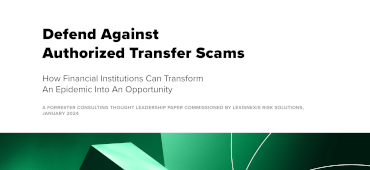
Prevent and Manage Fraud with a Unified Approach to Identity Trust
Unify Physical and Digital Identity Intelligence for a Complete View of Your Customers
- Traditional physical identities that show our offline lives and measure how we use identity information to interact with lenders and service providers.
- Digital identities that represent our online lives such as device identities, behavioral biometrics, and email addresses.
For most organizations, customer information is highly fragmented — the data is often scattered across various point providers and disconnected from corroborating identities. This lack of cohesiveness paves the way for fraudsters to deploy new strategies and multi-vector attacks, breaking through static defenses to pinpoint vulnerabilities.
LexisNexis® Risk Solutions combines physical and digital identities — including device, behavioral biometric and credit seeking insights— to bring the world of identity together for a 360-degree view of your customers. Our suite of fraud management and identity solutions let you apply the appropriate level of security-related friction for every interaction across the customer lifecycle to prevent fraud before it happens.

Defend Against Authorized Transfer Scams
LexisNexis Risk Solutions gives you the full 360-degree view of identity to prevent fraud while ensuring your customers have a smooth and secure end user experience.
Aggressively Combat and Prevent Fraud with an Increasing Level of Identity Trust Never Experienced Before

- Emailage® — a renowned expert in global email intelligence and enhanced predictive risk scores was acquired in March of 2020. Emailage® brings market leading expertise to assess fraud risk by utilizing email address metadata, a global contributory network and machine learning algorithms for incalculable benefits.
- ID Analytics®— a leader in leveraging physical identity insights from consumer application activity helps companies grow while balancing ever-present risk factors was acquired in January of 2020. By bringing ID Analytics into the fold, LexisNexis Risk Solutions is able to provide a unique cross-industry view of U.S. consumer application activity to enhance physical identity insights and fraud solutions.
These acquisitions brought intelligence networks, that when paired with the existing LexisNexis® Digital Identity Network® and LexisNexis Consumer Identity Network, create a constantly expanding collective view of identity activity, legitimacy and confirmed fraud. The end-result is a holistic picture of identity—the unification of physical identity events, consumer application activity, confirmed fraud, digital identity intelligence, email network insights, behavioral biometrics and global consumer recognition.
Use Fraud and Identity Insights to Apply Risk Appropriate Friction to Each Customer Interaction
Consumers are not monolithic and do not fall into neatly categorized buckets. As a result, organizations are increasingly charged with finding a way to interact and “meet them where they are”—whether it’s in person, online, on a mobile device or through another channel – without exposing their company or their customers to increased fraud risk.
Our full range of fraud and identity management tools securely and seamlessly segment risk throughout the customer lifecycle across a secure omni-channel environment allowing organizations to apply the right amount of fraud defense related friction to every customer interaction and enable your business to raise effectiveness and accuracy through:
Our fraud and identity management solutions provide you with real-time, on-demand consumer identity analytics, authentication and investigative insights to enable your business to effectively combat fraud and keep trusted transactions in efficient motion by:
- Detecting and blocking complex fraud
- Streamlining account opening and onboarding
- Reducing unnecessary customer friction and accelerating positive authentication
- Defending against emerging fraud threats through effective fraud identity management
- Optimizing ongoing account servicing
- Minimizing fraud losses and avoiding reputational risk
Gain a Unified Picture of Identity with One Comprehensive Solution Provider
In early 2018, LexisNexis Risk Solutions acquired ThreatMetrix˚ offering a new paradigm in fraud identity intelligence. The acquisition added powerful digital identity intelligence capabilities with global coverage, unifying decision analytics across both the customer’s physical and digital journey. LexisNexis® ThreatMetrix® provides digital identity intelligence and authentication powered by insights from billions of transactions and embedded machine learning as the only end-to-end enterprise fraud management solution.
Today, LexisNexis Risk Solutions provides critical insights and capabilities to help prevent fraud with risk appropriate friction for an optimal customer experience. Our fraud detection and management solutions enable organizations to:
- Make physical and digital connections that distinguish fraudulent from legitimate patterns across channels that go beyond physical authentication verification—such as name, address, date of birth or a CVV code associated with a card—to include active ID verification, digital identity biometrics and device assessment
- Blend physical and digital identity to get the full view of the customer that is essential for detecting fraud anomalies based on device use, linkages, remote channel behaviors, locations and patterns

Best of all, after evaluating the physical and digital footprint, organizations can quickly turn around and deploy appropriate authentication and identity fraud management capabilities based on the risk of each consumer interaction from one trusted source without relying on disparate multiple provider solutions.
Discover What Others Influencers are Saying about Our Award-Winning Fraud Defense and Fraud Management Solutions

Forrester®

Card Not Present®

CyberSecurity Breakthrough
“LexisNexis Risk Solutions is transforming risk decision making, delivering a comprehensive fraud, identity and authentication solution that recognizes good, returning customers and detects anomalies in behavior of all users to better model future fraud risks.”
James Johnson
Adapt to an Ever Changing Fraud Environment with Transformative Fraud Detection Solutions
LexisNexis Risk Solutions offers best-of-class fraud solutions for a strong multi-layered defense that reduce fraud and costs to your business.
Discover how our fraud and identity management solutions support confident decisions across the customer lifecycle.

Fraud Analytics

Identity Verification and Authentication

Manual Review and Fraud Investigations
Manage fraud more comprehensively with LexisNexis® Risk Solutions.
We believe in the power of data and analytics
to manage risk & uncover opportunity.
Products You May Be Interested In
-
BehavioSec®
Transform human interactions into actionable intelligence
Learn More -
Digital Identity Network
Gain the ability to recognize good, returning customers and weed out fraudsters, all in near real time
Learn More -
Flex ID
Speed customer onboarding and extend reach into expanding markets
Learn More -
FraudPoint®
Combat identity fraud with sophisticated scoring and leading analytics
Learn More -
Instant Age Verify
Verify identities and ages
Learn More -
Instant Verify
Verify IDs and professional credentials instantly
Learn More -
InstantID®
Complete identity verification, spot fraud and uncover identity discrepancies in real time
Learn More -
InstantID® Business
Verify the business and its authorized agents... without awkward pauses
Learn More -
InstantID® Q&A
Authenticate customer identities in real-time
Learn More -
LexisNexis® Emailage®
Get a clear picture of who is behind a transaction and the associated risk, so your team can automate decision workflows, improve customer experience, all in near-real time
Learn More -
LexisNexis® Fraud Intelligence
LexisNexis® Fraud Intelligence predicts the likelihood a new application will result in fraud
Learn More -
LexisNexis Risk Management Solutions®
Manage risk with technology, information and advanced analytics
Learn More -
One Time Password
Authenticate a user with a one-time login transaction
Learn More -
Phone Finder
Connect phones and identities with rank-ordered results
Learn More -
Relationship Identifier
Identify undisclosed relationships between individuals and businesses
Learn More -
ThreatMetrix®
Enable cybersecurity and risk management through data science innovation and shared intelligence
Learn More -
TrueID®
Recognize a true identity and fight fraud in real time
Learn More -
Verification of Occupancy
Protect your portfolio while preserving profitability
Learn More
